Oil in Water Analyzer Working Principle
Basic operation of OIl In Water Analyzer
There are different technologies available to measure the oil in water like infrared, semiconductor-based sensors, UV fluorescent, UV absorbance, etc. The UV fluorescent technology is mostly used in the oil and gas industries.
Oil in Water Analyzer

Principle
The main principle is when a UV light source passes through the oil in water sample then the oil molecules will be excited to a higher energy level.
Then the excited molecule will again come back to its normal state (lower-energy level), during this process the molecules emits a light called as fluorescence light.
By measuring this fluorescence light, we can determine the oil in water.
Operation
A UV lamp is used to generate the ultraviolet light source which is used to excite the oil molecules. This UV source is then passed through an excitation filter to pass the selected wavelengths and block the remaining wavelengths, as per our design.
Then the filtered UV source will be passed through a flow cell (also called as sample chamber or sample cell).
The oil molecules will absorb the UV light and the oil molecules' energy level will change from lower to higher state. After some time, the molecules will again come backs from a high state to a low state, during this time the molecules emit a light outside and this is called as fluorescence light.
A set of photo-detectors (measured and sample) is used to measure the oil in water by measuring the generated fluorescence light.
Advantages
- Long life of UV lamp
- Easy to operate, calibrate, and maintain
- High sensitivity
No comments yet. Login to start a new discussion Start a new discussion